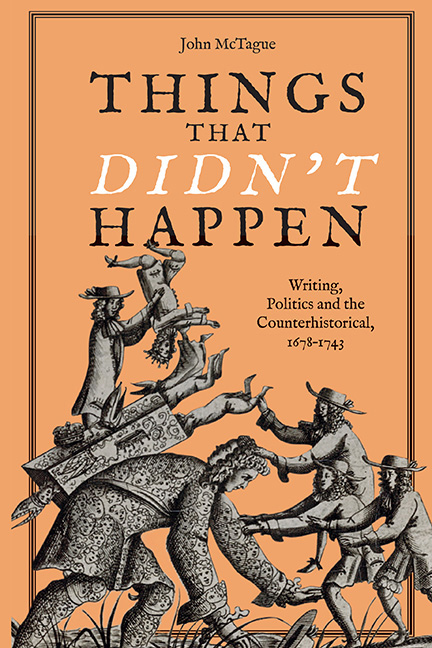Book contents
- Frontmatter
- Dedication
- Contents
- List of Illustrations
- Acknowledgements
- List of Abbreviations
- Introduction
- I Fabrications
- 1 Incorrigibility: The Warming Pan Scandal of 1688–89
- 2 ‘Working in th'immediate power to be’: The Popish and Protestant Plots
- II Failures
- III Speculations
- IV The Dunciads
- Conclusion: Events that Didn't Happen
- Bibliography
- Index
1 - Incorrigibility: The Warming Pan Scandal of 1688–89
from I - Fabrications
Published online by Cambridge University Press: 09 October 2019
- Frontmatter
- Dedication
- Contents
- List of Illustrations
- Acknowledgements
- List of Abbreviations
- Introduction
- I Fabrications
- 1 Incorrigibility: The Warming Pan Scandal of 1688–89
- 2 ‘Working in th'immediate power to be’: The Popish and Protestant Plots
- II Failures
- III Speculations
- IV The Dunciads
- Conclusion: Events that Didn't Happen
- Bibliography
- Index
Summary
ABOVE a cosmetics shop and beauty salon housed in a Georgian building standing between Old Bond and Burton Streets in Bath, in a niche in the north-facing wall, there is a cherub. This small statue is a relic of the controversy surrounding the birth on 10 June 1688 of James Francis Edward Stuart, the son of James II and queen Mary of Modena. As the male heir to the Catholic James II, this child supplanted James's Protestant daughter, Mary, princess of Orange, and his birth raised the spectre of extended Catholic rule in England. Much of this chapter is concerned with the extraordinary measures English Protestants and Whigs took, and the extraordinary positions they adopted, in order to dismantle this new Prince of Wales's legitimacy: he was not the king's son, but the progeny of the papal nuncio; the queen's ‘belly’ was false, the child a commoner (the son of a miller, or a bricklayer), and smuggled into St James's Palace while the queen feigned the pangs of labour. Despite the many enemies James II had made, however, he was not without supporters in the summer of 1688. One such supporter was James Drummond, 1st Earl of Melfort. Upon the news of the queen's pregnancy, he commissioned a monument to be erected in Bath to commemorate the coming of the heir. This elaborate piece, costing £1500, was located at the Cross Bath, which the queen had visited in 1687 in an attempt to cure the fertility problems that had been plaguing her and her husband for years. The monument strongly implied a divine hand in the prince's conception: a descending dove, figuring the Holy Spirit, was supported by a trinity of columns. It was finished off with three cherubim, a crown of thorns and a cross: exactly the kind of idolatrous statuary that would provoke Anglicans and Dissenters. Should anyone have missed the symbolism, it is spelt out in a Latin inscription dedicating the monument to Mary of Modena, hailing her as ‘the mother of three kingdoms’ and describing the Holy Spirit moving through the bath's waters.
- Type
- Chapter
- Information
- Things that Didn't HappenWriting, Politics and the Counterhistorical, 1678–1743, pp. 27 - 54Publisher: Boydell & BrewerPrint publication year: 2019



